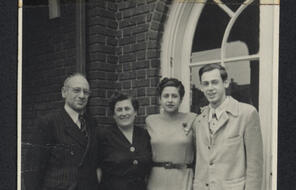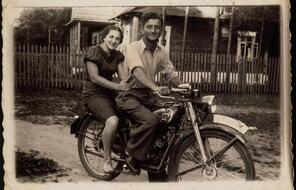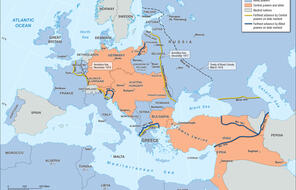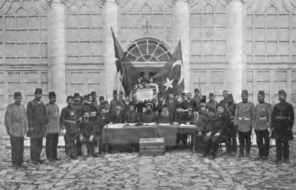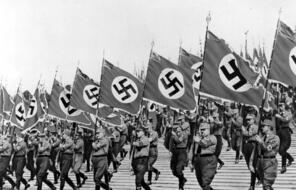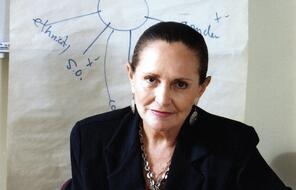Women in the Weimar Republic
At a Glance
Language
English — USSubject
- Civics & Citizenship
- History
- The Holocaust
- Human & Civil Rights
A crowd of women standing in line at a polling station in the Weimar Republic in 1919, the first year women were allowed to vote.
At the turn of the twentieth century, women throughout Europe and North America were demanding that their governments give them the right to vote. Germany was no exception; women began to hold demonstrations for women’s suffrage there as early as 1910. They succeeded in 1919, when Article 109 of the Weimar Constitution stated that men and women have the same fundamental rights and duties as citizens, including the right to vote and to hold office. During the years of the Weimar Republic, the majority of the electorate was female, in part because so many men had died in the war or were so physically or psychologically wounded that they were unlikely to vote. In 1919, the first year women could vote in Germany, they held 10% of the seats in the Reichstag, and their numbers continued to rise throughout the next decade.
During and after the war, the position of women in the workforce also began to change. While the proportion of women who had jobs remained about the same as before the war, women began to take new kinds of jobs that had previously been dominated by men. For instance, they began to fill more jobs that were visible throughout society, such as tram conductor and department store clerk, as well as (in smaller numbers) factory worker, lawyer, and doctor. While many of these positions would return to men after the war, women also moved into professions that many would continue to associate with women in the years that followed, such as teaching, social work, and secretarial work. All in all, more than 11 million women were employed in Germany in 1918, accounting for 36% of the work force. 1
As women gained more power in both society and government, their position in society began to change:
Social observers of all political persuasions—from journalists and sociologists to government experts and political leaders—detected the emergence of a “new woman” and a “new family” in the 1920s. Indeed, Weimar culture did produce a certain heady and intoxicating sense of freedom in the big cities, especially for some intellectual and professional women . . . 2
Alice Rühle-Gerstel was one of these “new women” in the 1920s. As a psychologist, she closely followed the way that the role of women in society was changing. In 1933, she wrote about the changes she had observed during the previous decade:
Women began to cut an entirely new figure. A new economic figure who went out into public economic life as an independent worker or wage-earner entering the free market that had up until then been free only for men. A new political figure who appeared in the parties and parliaments, at demonstrations and gatherings. A new physical figure who not only cut her hair and shortened her skirts but began to emancipate herself altogether from the physical limitations of being female. Finally, a new intellectual-psychological figure who fought her way out of the fog of sentimental ideologies and strove toward a clear, objective knowledge of the world and the self. 3
Yet, according to Rühle-Gerstel, the “new women” were “pioneers” who never constituted a majority and did not succeed in changing most Germans’ ideas about the role of women in society. She noted, “Before [the new woman] could evolve into a type and expand into an average, she once again ran up against barriers.” 4 Promises of economic gains and a stronger voice in politics were fulfilled slowly, if at all. War veterans had gradually returned to civilian life, reclaiming their jobs as well as their role as family breadwinner. Business leaders and politicians began to advocate that women return to the more traditional roles of wife and mother. Mother’s Day was promoted as an important day of national celebration, along with the slogan Kinder, Küche, Kirche (“children, kitchen, church”) as the right path for German women. Historians Renate Bridenthal and Claudia Koonz write that many of Germany’s major political parties believed that reinforcing the traditional roles of women and men in the family “would provide stability in a social world that seemed to be rapidly slipping from their control.” They continue:
Instead of guaranteeing equality to women who chose to live outside this structure [of the traditional female role], they sought to make motherhood more attractive. Thus, Kinder, Küche, Kirche was upgraded from a responsibility to a calling through home economics courses, homemaker helper programs, and social work projects. In this way, politicians of the center and right endeavored to make traditional roles attractive to a new generation by underwriting the father's authority and the mother's responsibility within the family. 5
In addition, some German women never fully embraced the “new woman” and continued to hold traditional views about their place in society, criticizing younger women who “preferred dance-halls to reading groups.” 6
By the end of the decade, when economic uncertainty once again gripped Germany (see reading, A New Economic Crisis), an increasing number of women were turning toward conservative parties like the Nazis, who made Kinder, Küche, Kirche for women an integral part of their proposed program.
- 1Detlev Peukert, The Weimar Republic: The Crisis of Classical Modernity (New York: Hill and Wang, 1992), 96–97; Richard J. Evans, The Coming of the Third Reich (New York: Penguin, 2003), 127.
- 2Renate Bridenthal, Atina Grossman, and Marion Kaplan, eds., When Biology Became Destiny: Women in Weimar and Nazi Germany (New York: Monthly Review Press, 1984), 11–12.
- 3Alice Rühle-Gerstel, “Back to the Good Old Days?,” in The Weimar Republic Sourcebook, ed. Anton Kaes, Martin Jay, and Edward Dimendberg (University of California Press, 1994), 218.
- 4Alice Rühle-Gerstel, “Back to the Good Old Days?,” in The Weimar Republic Sourcebook, ed. Anton Kaes, Martin Jay, and Edward Dimendberg (University of California Press, 1994), 218.
- 5Renate Bridenthal, Atina Grossman, and Marion Kaplan, eds., When Biology Became Destiny: Women in Weimar and Nazi Germany (New York: Monthly Review Press, 1984), 43.
- 6Richard J. Evans, The Coming of the Third Reich (New York: Penguin, 2003), 129.
Women Voting in the Weimar Republic
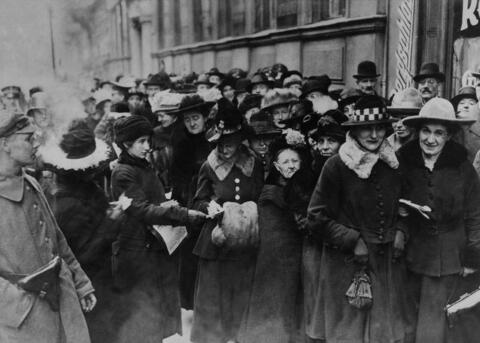
Women Voting in the Weimar Republic
A crowd of women standing in line at a polling station in the Weimar Republic in 1919, the first year women were allowed to vote.
Connection Questions
- How did the role of women in German society change in the Weimar Republic? What barriers to sustaining those changes did women encounter?
- Why might some people view the changing status of women as threatening, not only to men but to the nation as a whole? Why might some women also resist changes in women’s roles?
- How can a country be assured that rights accorded to women during a particular period are sustained? Are laws that grant new rights to women sufficient to change attitudes?
How to Cite This Reading
Facing History & Ourselves, "Women in the Weimar Republic," last updated August 2, 2016.





